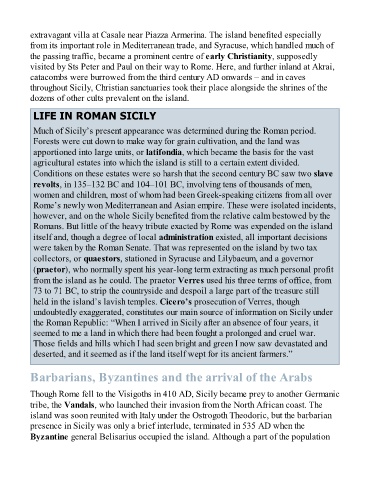Page 563 - The Rough Guide of Sicily
P. 563
extravagant villa at Casale near Piazza Armerina. The island benefited especially
from its important role in Mediterranean trade, and Syracuse, which handled much of
the passing traffic, became a prominent centre of early Christianity, supposedly
visited by Sts Peter and Paul on their way to Rome. Here, and further inland at Akrai,
catacombs were burrowed from the third century AD onwards – and in caves
throughout Sicily, Christian sanctuaries took their place alongside the shrines of the
dozens of other cults prevalent on the island.
LIFE IN ROMAN SICILY
Much of Sicily’s present appearance was determined during the Roman period.
Forests were cut down to make way for grain cultivation, and the land was
apportioned into large units, or latifondia, which became the basis for the vast
agricultural estates into which the island is still to a certain extent divided.
Conditions on these estates were so harsh that the second century BC saw two slave
revolts, in 135–132 BC and 104–101 BC, involving tens of thousands of men,
women and children, most of whom had been Greek-speaking citizens from all over
Rome’s newly won Mediterranean and Asian empire. These were isolated incidents,
however, and on the whole Sicily benefited from the relative calm bestowed by the
Romans. But little of the heavy tribute exacted by Rome was expended on the island
itself and, though a degree of local administration existed, all important decisions
were taken by the Roman Senate. That was represented on the island by two tax
collectors, or quaestors, stationed in Syracuse and Lilybaeum, and a governor
(praetor), who normally spent his year-long term extracting as much personal profit
from the island as he could. The praetor Verres used his three terms of office, from
73 to 71 BC, to strip the countryside and despoil a large part of the treasure still
held in the island’s lavish temples. Cicero’s prosecution of Verres, though
undoubtedly exaggerated, constitutes our main source of information on Sicily under
the Roman Republic: “When I arrived in Sicily after an absence of four years, it
seemed to me a land in which there had been fought a prolonged and cruel war.
Those fields and hills which I had seen bright and green I now saw devastated and
deserted, and it seemed as if the land itself wept for its ancient farmers.”
Barbarians, Byzantines and the arrival of the Arabs
Though Rome fell to the Visigoths in 410 AD, Sicily became prey to another Germanic
tribe, the Vandals, who launched their invasion from the North African coast. The
island was soon reunited with Italy under the Ostrogoth Theodoric, but the barbarian
presence in Sicily was only a brief interlude, terminated in 535 AD when the
Byzantine general Belisarius occupied the island. Although a part of the population

